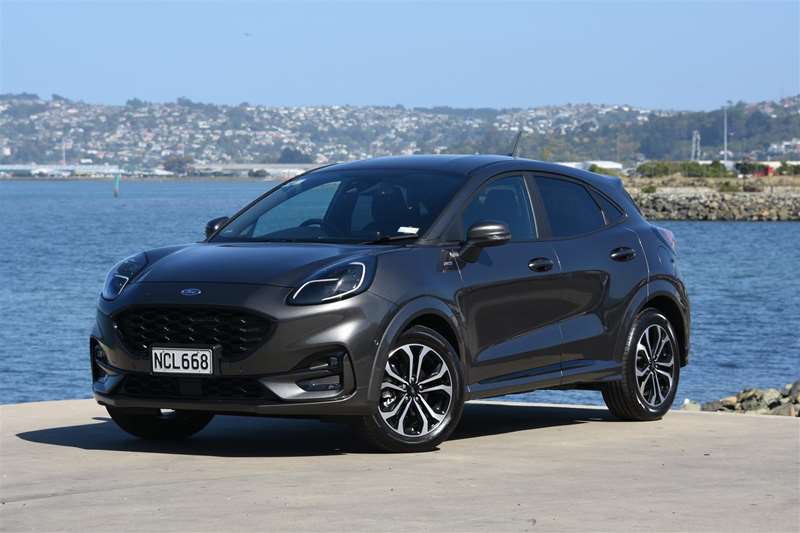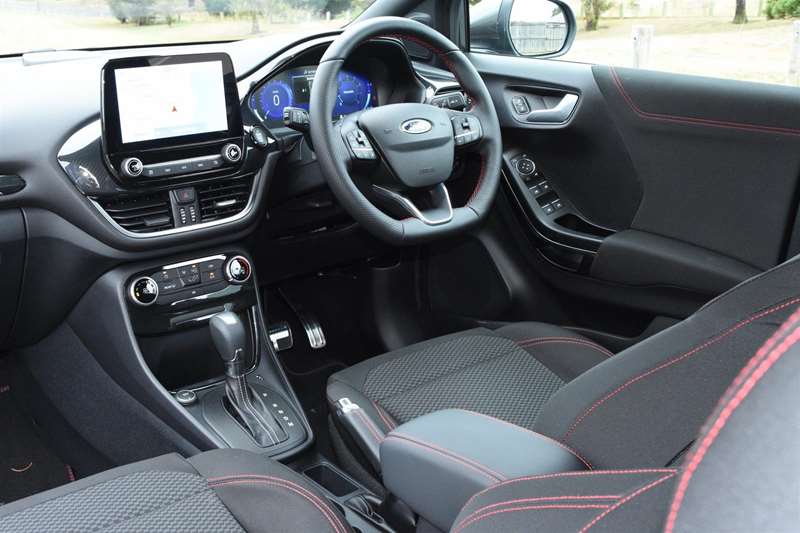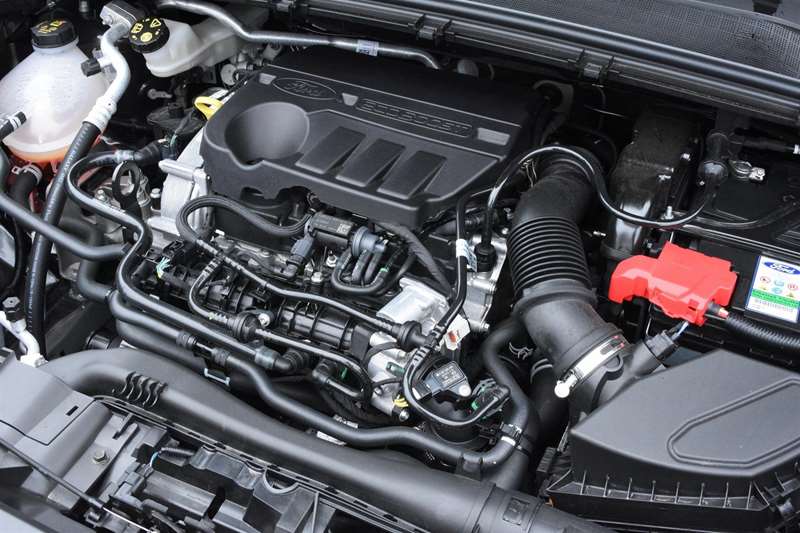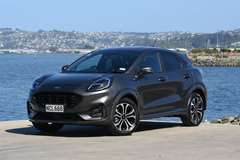As successor to the underwhelming EcoSport, the new Puma offers Ford a real crack at success in the booming compact SUV market. David Thomson takes the flagship ST-Line for a spin.
What’s new?
The last time Ford played in the compact SUV segment there wasn’t much to get excited about. You might remember the EcoSport, which was never a strong seller here.
Ford’s replacement, the Puma, is a far stronger contender in a segment that is brimming with talent. They come in droves from Japan, Korea and Europe, and include well-established models such as the Mazda CX-3 as well as more recent arrivals such as the Kia Seltos and Toyota Yaris Cross.
The Puma slots into the local Ford line-up as the brand’s smallest crossover SUV.
Like its key rivals, the Puma sits on conventional car underpinnings, sharing its five-door layout, core mechanicals, and much of its underlying structure with the Fiesta hatchback. That said, Puma’s platform is a stretched version of that used for Fiesta, featuring both a 95mm increase in wheelbase and 58mm wider track as well as greater overall length and width.
We only see the Fiesta here in peppy 1.5-litre ST-guise, but it is offered in most markets with a range of engine choices. It’s one of those engines — a 1.0-litre 92kW/170Nm turbo-petrol three-cylinder — that powers the two models that comprise the New Zealand Puma range. Both are front-wheel drive only, with power delivery entrusted to a seven-speed dual-clutch automated transmission.
Pricing opens at $33,990 for the standard Puma, while the ST-Line lists at $37,990.
What comes as standard?
Both Puma models run 215/55 tyres on 17-inch alloys and are supplied with a new Ford Drive Mode system. This provides specific selectable configurations of throttle response and traction control systems (and, on the ST-Line, different digital dash displays) for slippery roads and unsurfaced trails as well as the more convention sport, eco and normal settings.
The standard active safety package includes adaptive radar cruise, lane-keeping assistance, autonomous emergency braking with pedestrian and cyclist detection, a driver alert monitor, reversing camera and rear parking sensors. The ST-Line takes an enhanced safety suite that adds stop-go functionality to the cruise control along with front parking sensors, blind-spot detection, evasive steering assistance and forward collision warning systems.
ICT needs are met by Ford’s highly regarded SYNC3 system. This is based around an eight-inch centre-mounted colour touchscreen, and includes a six-speaker sound system, Apple Car Play and Android Auto compatibility, dual USB plug points and satellite navigation with speed sign recognition. Single-zone air-conditioning features on both models, while the ST-Line has keyless entry and a power-operated tailgate.
What’s it like to look at?
Ford’s design team has started fresh with the styling of the Puma rather than attempting to sculpt a high-riding interpretation of the Fiesta. This delivers a level of individuality that is not always achieved with contemporary compact crossovers.
The nose has a bug-eyed open-mouthed stance, with clever running lights detailed within the main headlights. A high waistline emphasises the Puma’s overall height, while there is a pronounced plunge to the roofline at the rear that is a neat counterpoint to the somewhat bulbous nose. The Puma name sprawls across the tail, which is tidily executed, and perhaps the most conventional part of the exterior design.
There are LED lights all round, but the ST-Line picks up a few visual adornments denied the standard Puma. These include a matte black front grille, machined black alloys, a larger rear spoiler and chrome-tipped exhaust.
What’s it like inside?
The cabin of the Puma is not nearly as bold as the exterior, and several features up front have been adapted directly from the Fiesta. Trimmed in dark colours, the test car presented a mix of soft-touch surfaces and harder finishes.
The dash is dominated by the prominent centre touchscreen, which is mounted above the air vents and air-conditioning controls.
While it looks tall, the Puma’s floor is set quite low, which makes for easy access to the cabin and ensures excellent headroom in the front.
The test car featured many interior enhancements. These included scuff plates, red contrast stitching, front sports seats, metallic pedals, a sports steering wheel with paddle shift controls and a digital instrument cluster.
As well as looking great, the ST-Line’s front sports seats are comfortable and supportive. The front of the cabin is also well-provisioned with storage spaces.
The back seats are reasonably comfortable, albeit with a slightly upright seating position and without a fold-down centre armrest. While not the most spacious rear seat in the class, the Puma will happily accommodate average-sized adults.
Standard boot space is a decent 410 litres, expanding to 1170 litres when the 60:40 split rear seat back is folded forward.
Having that power-operated tailgate on the ST-Line was a nice if not entirely necessary touch, but the rear cleverness in the Puma’s boot design is the configuration of the floor. It can be set at two heights, one to provide a flat load lip, and the other to maximise space. And, in either configuration, there’s also a sizeable plastic storage box located under the floor.
What’s it like to drive?
In choosing a compact crossover over a conventional hatchback, a customer is almost always trading dynamic prowess in return for practicality.
While the Puma doesn’t quite re-write the book in this regard, it certainly challenges current preconceptions by delivering a highly accomplished and engaging driving experience.
A relatively car-like driving position — the driver sits 60mm higher than in a Fiesta — ensures that the driver feels very much part of, rather the perched atop, the Puma. Aided also by nicely weighted and accurate steering and paddle shift controls, the test car was composed and well-balanced when pressed.
The test car also impressed with its ability to take poor surfaces, including mid-corner bumps and badly broken seal, in its stride.
To be fair, acceleration isn’t lightning quick even when in sport mode. However, the motor is zesty once the turbo spools up and has a characterful, if slightly discordant, three-cylinder growl.
Around-town driving is fuss-free, with a tight turning circle aiding manoeuvrability, and sensors and cameras to help parking. Open-road cruising is easy, too, albeit with refinement diminished by tyre noise over coarse-chip surfaces.
Economy-wise, the Puma manages a reasonable 5.3L/100km standard cycle figure. I didn’t manage to close in on that result on test, returning a 7.2L/100km on a drive programme that involved, admittedly, a fair proportion of spirited driving.
Verdict
Measured against the vehicle it replaced, the Puma represents a quantum leap. With that leap, Ford now has a contender in the booming compact crossover class, and one that will appeal to those seeking visual panache and driving fun as part of the package.
PHOTOS: DAVID THOMSON












